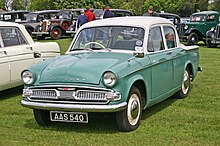Rootes Group
In the decade beginning 1928 the Rootes brothers, William and Reginald, made prosperous by their very successful distribution and servicing business, were keen to enter manufacturing for closer control of the products they were selling.
With the financial support of Prudential Assurance, the two brothers bought some well-known British motor manufacturers, including Hillman, Humber, Singer, Sunbeam, Talbot, Commer and Karrier.
Rootes Group was under-capitalised and unable to survive industrial relations problems and losses from the 1963 introduction of a new aluminium-engined small car, the Hillman Imp.
[3] They advertised that their showrooms in Devonshire House, Piccadilly could supply new cars priced from £145 to £3,000 manufactured by Rolls-Royce, Daimler, Sunbeam, Austin, Hillman, Fiat or Clyno.
A particular effort was put into overseas sales and it became clear the export opportunities warranted a move into car manufacture, which was achieved in 1929 by the purchase of controlling interests in first Hillman followed by Humber and Commer.
There was a resurgence in domestic and export demand for pedal bicycles, and in February 1932 Raleigh acquired all the Humber cycles trade marks.
During the Depression more businesses were picked up as they came available: Karrier (1934), Sunbeam (1934), Clement Talbot (1934) and British Light Steel Pressings (1937) were all bought and made subsidiaries of Humber Limited.
London's Mayfair coachbuilders and Rolls-Royce and Daimler dealers Thrupp & Maberly had been bought in 1926[2] their royal warrant always proudly displayed.
Thereafter the business's expansion was financed by retained profits supplemented where necessary, for example the purchase of Hillman, by loans from Prudential and the company's bankers principally Midland Bank.
In 1940, under the Government's shadow factory scheme, Rootes built its massive assembly plant in Ryton-on-Dunsmore, near Coventry, initially manufacturing aircraft, one of the first types being the Bristol Blenheim.
Rootes successfully sold a range of cars priced at a slight premium to their major home market competitors, justified on the basis that they offered a level of superiority in design and finish.
Their 2-1/2 and 3-litre cars were re-styled in the mid-1930s and renamed Humber Snipe and their small Minx was made the mainstay bread and butter member of the Rootes range.
Karrier represented mainly municipal and special-purpose trucks, vans and buses, though towards the end included badge-engineered models from the Commer range.
It was intended to be a response from Rootes to rival British Motor Corporation's popular Mini, and a new factory (called the Linwood plant) on the boundary between Paisley and Elderslie, Renfrewshire was built for its assembly.
The move to Linwood was forced upon the company by the British government, which had introduced the principle of industrial development certificates (IDCs) to build factories in depressed areas.
The Imp itself was underdeveloped, and the build quality and reliability problems, coupled with buyer apathy towards the design were reflected in poor sales.
Lost production caused by frequent strike action at Linwood and escalating warranty claims[citation needed] left Rootes no money to develop other models.
Stirling Moss and Sheila van Damm were their top drivers, and the Sunbeam-Talbot 90's win in the 1955 Monte Carlo Rally was the most significant victory.
Driving a Hillman Hunter, Andrew Cowan gained what was regarded as a surprise victory against stiff competition from other factory teams with bigger budgets.
[22] By the mid-1960s, Rootes was progressively taken over by Chrysler of the United States, following huge losses amid the commercial failure of the troubled Imp.
Chrysler was also keen to take control of the struggling firm as it wished to have its own wholly independent European subsidiaries like archrivals Ford and General Motors.
In the early 1970s, with the rise of interest in sub-compact cars, Chrysler offered the Hillman Avenger in North America as the Plymouth Cricket.
By the early 1970s, Chrysler Europe was working on the development of two new family car ranges which would be produced at both its British and French plants, and sold under both the Chrysler and Simca marques on the relevant markets - similar to the integration of British and German model ranges which its rivals Ford and General Motors were carrying out at the time.
Unfortunately, with its problems in the US, Chrysler did not have the capital to invest in refreshing their entire product range, and sales of the older designs stagnated in the face of more modern competition.
Despite the government assistance, the weight of problems bearing on Chrysler Europe resulted in its collapse in 1977, leading to the company's 1978 takeover by PSA Peugeot-Citroen.
PSA soon wielded the axe over the troubled Linwood factory in Scotland, and exhumed the Talbot marque from the pages of Rootes' history to re-badge the former Chrysler and Simca badged models.
However, the Talbot-badged models declined in popularity over the next few years, with sales dropping from nearly 120,000 on the UK market in 1979 to around 25,000 in 1984, while at the same time the Peugeot brand was gaining ground thanks to the success of the 205.
It marked the end of nearly 60 years of car manufacturing at Ryton, and severed the motor industry's final remaining direct link with the Rootes Group.
The only physical remnant of the Rootes Group still in existence is the Whitley research and development centre - originally established during the Chrysler era, but subsequently sold by PSA and is now owned by Jaguar Land Rover.
One of the original buildings remains, the Talbot administration block now known as Ladbroke Hall, with the earl's crest high above its main entrance.













